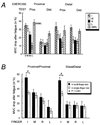The effect of a fatiguing exercise by the index finger on single- and multi-finger force production tasks
- PMID: 11460770
- PMCID: PMC2830622
- DOI: 10.1007/s002210100698
The effect of a fatiguing exercise by the index finger on single- and multi-finger force production tasks
Abstract
We studied the effects of fatigue, induced by a 60-s maximal isometric force production with the index finger, on multi-finger coordination and force production by the other fingers of the hand. Finger forces were measured during single- and multi-finger maximal voluntary force production (MVC) at two sites, the middle of the distal or the middle of the proximal phalanges. Two fatiguing exercises involving force production by the index finger were used, one at the distal phalanx and the other at the proximal phalanx. The MVC of the index finger dropped by about 33% when it was produced at the site involved in the fatiguing exercise. In addition, large transfer effects of fatigue were observed across sites of force application and across fingers. Force deficit increased under fatigue, especially due to a drop in the recruitment of the index finger. Under fatigue, the index finger was less enslaved during force production by other fingers. During multi-finger tasks, the percentage of total force produced by the index finger was significantly reduced after the fatiguing exercise. The principle of minimization of secondary moments was violated under fatigue. We suggest that the most impaired (fatigued) finger shows less interaction with other fingers or, in other words, is being progressively removed from the multi-finger synergy. Some of the observed changes in finger coordination suggest effects of fatigue at a central (neural) level.
Figures




Similar articles
-
Error compensation during finger force production after one- and four-finger voluntarily fatiguing exercise.Exp Brain Res. 2007 Aug;181(3):461-8. doi: 10.1007/s00221-007-0942-z. Epub 2007 Apr 19. Exp Brain Res. 2007. PMID: 17443316 Free PMC article.
-
The effect of fatigue on multifinger co-ordination in force production tasks in humans.J Physiol. 2000 Mar 1;523 Pt 2(Pt 2):523-32. doi: 10.1111/j.1469-7793.2000.00523.x. J Physiol. 2000. PMID: 10699094 Free PMC article.
-
Finger interaction during accurate multi-finger force production tasks in young and elderly persons.Exp Brain Res. 2004 Jun;156(3):282-92. doi: 10.1007/s00221-003-1786-9. Epub 2004 Feb 19. Exp Brain Res. 2004. PMID: 14985892
-
The effect of metabolic alkalosis on central and peripheral mechanisms associated with exercise-induced muscle fatigue in humans.Exp Physiol. 2015 Apr 20;100(5):519-30. doi: 10.1113/EP085054. Exp Physiol. 2015. PMID: 25727892 Review.
-
Optimization-based models of muscle coordination.Exerc Sport Sci Rev. 2002 Jan;30(1):32-8. doi: 10.1097/00003677-200201000-00007. Exerc Sport Sci Rev. 2002. PMID: 11800497 Free PMC article. Review.
Cited by
-
Optimality versus variability: effect of fatigue in multi-finger redundant tasks.Exp Brain Res. 2012 Feb;216(4):591-607. doi: 10.1007/s00221-011-2963-x. Epub 2011 Dec 1. Exp Brain Res. 2012. PMID: 22130781 Free PMC article.
-
Time-dependent adaptations to posture and movement characteristics during the development of repetitive reaching induced fatigue.Exp Brain Res. 2011 May;211(1):133-43. doi: 10.1007/s00221-011-2661-8. Epub 2011 Apr 12. Exp Brain Res. 2011. PMID: 21484395
-
Does muscle fatigue change motor synergies at different levels of neuromotor control?Front Hum Neurosci. 2025 Jan 7;18:1519462. doi: 10.3389/fnhum.2024.1519462. eCollection 2024. Front Hum Neurosci. 2025. PMID: 39839368 Free PMC article.
-
Learning effects on muscle modes and multi-mode postural synergies.Exp Brain Res. 2008 Jan;184(3):323-38. doi: 10.1007/s00221-007-1101-2. Epub 2007 Aug 28. Exp Brain Res. 2008. PMID: 17724582 Free PMC article.
-
Perception of finger forces within the hand after index finger fatiguing exercise.Exp Brain Res. 2007 Sep;182(2):169-77. doi: 10.1007/s00221-007-0978-0. Epub 2007 May 24. Exp Brain Res. 2007. PMID: 17522850 Free PMC article.
References
-
- Aymard C, Katz R, Laffite C, Le Bozec S, Penicaud A. Changes in reciprocal and transjoint inhibition induced by muscle fatigue in man. Exp Brain Res. 1995;106:418–424. - PubMed
-
- Basmajian JV, De Luca CJ. Muscles alive. 5th edn. Baltimore, MD: Williams and Wilkins; 1985.
-
- Bemben MG, Massey BH, Bemben DA, Misner JE, Boileau RA. Isometric intermittent endurance of four muscle groups in men aged 20–74 yr. Med Sci Sport Exer. 1996;28:145–154. - PubMed
-
- Bigland-Ritchie B, Woods JJ. Changes in muscle contractile properties and neural control during human muscle fatigue. Muscle Nerve. 1984;7:691–699. - PubMed
-
- Bonnard M, Sirin AV, Oddson L, Thorstensson A. Different strategies to compensate for the effects of fatigue revealed by neuromuscular adaptation processes in humans. Neurosci Lett. 1994;166:101–105. - PubMed
Publication types
MeSH terms
Grants and funding
LinkOut - more resources
Full Text Sources

